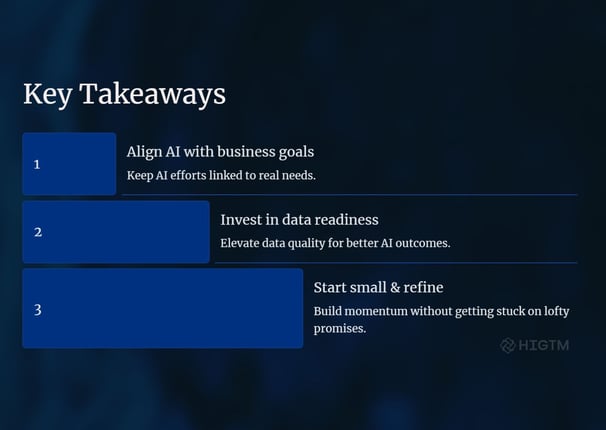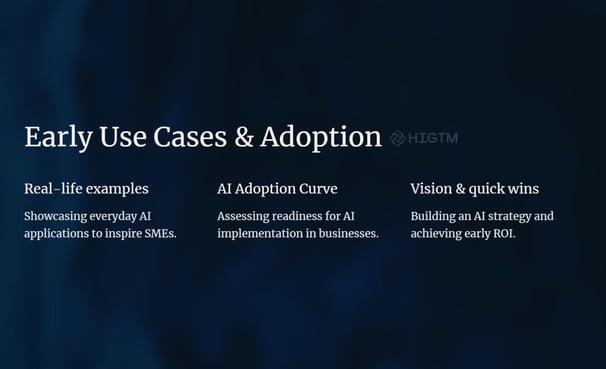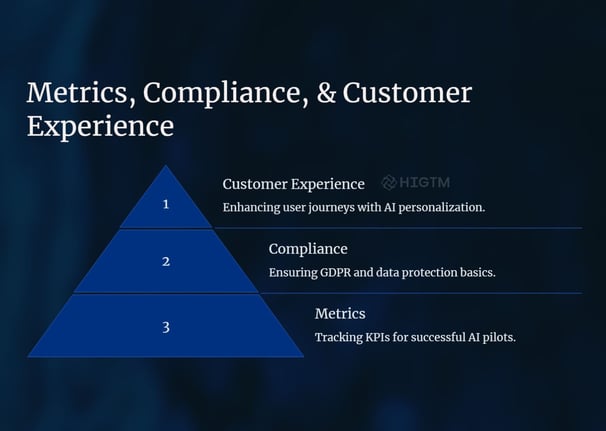31. Chapter 1 Wrap-Up – Recap of Core Concepts & Next Steps
Over the last 30 topics, we explored the fundamentals of AI in small and medium-sized enterprises (SMEs)—covering definitions, practical tools, data handling, budgeting, user engagement, skill requirements, and more. This wrap-up consolidates those insights, offering a clearer roadmap for your continued AI journey. If you’re looking for an easy reference, this article highlights the essentials, each rooted in real-world cases and tips from earlier discussions.
Q1: FOUNDATIONS OF AI IN SME MANAGEMENT - CHAPTER 1 (DAYS 1–31): CORE AI CONCEPTS & VALUE PROPOSITION
Gary Stoyanov PhD
1/31/20255 min read

1. Foundations of AI for SMEs (Topics 1–5)
1.1 What is AI & Key Terminologies
We began by defining artificial intelligence as systems or machines mimicking human-like reasoning or learning. Core terms included machine learning (where algorithms learn from data), deep learning (multi-layered neural networks), and NLP (tools that process human language). These building blocks emphasize data-driven solutions that adapt over time rather than running on fixed rules.
1.2 Why SMEs Need AI
We saw AI’s potential in streamlining operations, guiding customer insights, and staying relevant in competitive markets. Big players might have large budgets, but SMEs can leverage simpler solutions or incremental approaches to uncover their own AI advantages.
1.3 Common AI Misconceptions
Some assume AI is too expensive or complicated. Others fear it will replace human roles. We debunked these myths, showing that smart adoption can boost roles rather than remove them, and that smaller budgets still allow meaningful progress.
1.4 Narrow vs. General AI
We drew a line between task-focused narrow AI (like recommendation engines) and broader concepts of general AI, which remain more theoretical. SMEs mostly benefit from narrow solutions that target specific pain points.
2. Early Use Cases & Adoption Strategies (Topics 6–10)
2.1 AI in Daily Life
From chatbots to facial recognition, we saw how modern life intersects with AI. For SMEs, these examples offered sparks of creativity—be it simple scheduling bots or automated email classification.
2.2 The AI Adoption Curve
Assessing readiness helps you see where your organization stands, from basic interest to full-scale deployment. Stepwise growth ensures each phase has measurable wins.
2.3 Identifying Pain Points
Pinpointing high-value problems (like repetitive tasks or data bottlenecks) sets the stage for AI to step in. AI thrives on well-defined questions and data sets, transforming these into solvable tasks.
2.4 AI vs. Automation
We compared automation (handling repetitive chores) and AI (adapting, learning) but also noted the synergy between them. A machine that performs tasks repeatedly might gain extra insight from AI.
2.5 Building an AI Vision
A clear vision articulates your AI aspirations—like boosting user satisfaction or cutting operational costs. Quick pilots, or “quick wins,” anchor that vision in tangible results, easing everyone into the technology.
3. ROI, Leadership, & Early Tools (Topics 11–15)
3.1 Calculating & Communicating ROI
Return on investment helps you secure internal buy-in. By defining metrics—like cost reduction or revenue growth—everyone sees AI’s value. We also learned to highlight intangible benefits (like brand trust or staff morale) where possible.
3.2 Leadership Mindset
Strong leadership fosters a pro-innovation culture. By championing AI, leaders inspire teams to learn new skills. They also steer the organization away from hype-driven illusions, grounding AI projects in feasible goals.
3.3 Early-Stage AI Tools
We discovered low/no-code platforms that enable simple experimentation—like a chatbot or data analysis dashboard—without the cost of building custom solutions from scratch. This path helps teams gather confidence before tackling more advanced projects.
3.4 Barriers to Adoption
We noted cost, data, skills, and cultural roadblocks. Each requires a measured approach—like phased spending, training, or adopting user-friendly solutions. Surpassing these barriers sets a solid AI launchpad.
3.5 Success Stories & Global Case Highlights
Examining short stories from around the world proved that SMEs of varying sizes can deploy AI effectively if they define tight, achievable objectives and harness existing data.
4. AI Readiness & Ethical Standards (Topics 16–20)
4.1 Readiness Assessment
A structured evaluation of data handling, staff skills, and leadership support clarifies your starting point. This lowers project risk.
4.2 AI Ethics
Customers and employees deserve fair, transparent AI. Policies that minimize biases, respect privacy, and clarify data usage build trust. SMEs that follow these standards often find better user engagement.
4.3 Data Collection & Quality
Accurate, relevant data powers AI. Sloppy or inconsistent records produce poor outcomes. Focusing on data curation helps smaller organizations keep AI results consistent.
4.4 Cloud vs. On-Prem AI
We weighed costs, scalability, and control. Some prefer cloud for quick scaling, others pick on-prem for data security or compliance. Each choice aligns with your budget and growth trajectory.
4.5 Budgeting for AI
Early cost considerations revolve around pilot funding, staff training, and possible vendor fees. Setting realistic goals ensures no illusions about immediate breakthroughs, preventing disappointment or wasted finances.
5. Internal Awareness, Pitfalls, & Scalability (Topics 21–25)
5.1 Building Internal Awareness
Educating employees fosters a supportive environment. Staff training or “lunch & learns” demystify AI, reduce fear, and encourage idea-sharing across departments.
5.2 Common AI Pitfalls
Overpromising leads to stakeholder fatigue if lofty claims fail to materialize. Underdelivering can dull enthusiasm. Balanced expectations and iterative releases keep momentum healthy.
5.3 Scalability Concerns
We must think about tomorrow’s data loads and user demands. Planning for future expansions—like modular architecture, robust data pipelines—avoids painful overhauls later on.
6. Early Metrics, Compliance, & Personalization (Topics 26–28)
6.1 Early KPIs for AI Pilots
Simple metrics, such as accuracy, processing time reduction, or user adoption, reveal if pilots are on track. Choose these carefully for each pilot’s scope.
6.2 Regulations & Compliance
GDPR and other data laws affect how personal data is gathered, stored, and processed. Even small businesses must watch for compliance to protect trust and dodge fines.
6.3 Personalization Benefits
Tailored suggestions, from recommended products to customized emails, increase user satisfaction and sales. We saw how even basic personalization can produce meaningful lifts in engagement.
7. AI Talent & Real-Life Success (Topics 29–30)
7.1 Talent Needs & Skill Gaps
Key roles—data scientists, ML ops engineers, BI analysts, project leads—balance technical depth with strategic oversight. Smaller teams might outsource or combine roles for practicality.
7.2 Small Retailer Case Study
A modest retailer saw a 15% boost in average order value by using an AI-powered product recommendation engine. This real story highlighted the importance of data cleanup, pick-and-choose AI solutions, and simple pilot tracking.
8. Patterns & Themes Across Topics
Data as the Lifeblood: Clean, well-labeled data keeps AI endeavors strong.
Iterative Mindset: Start with small pilots, measure progress, refine, and scale.
Cultural Buy-In: Leadership support, staff training, and cross-functional engagement ensure AI doesn’t languish in departmental silos.
ROI Awareness: Clear financial or strategic benefits drive stakeholder approval.
Privacy & Ethics: Handling data responsibly fosters user trust and smooth expansions.
9. Next Steps for SMEs
Review & Reflect: Identify which topics stand out for your organization. Is data readiness lacking? Are you missing leadership alignment?
Build a Roadmap: Plan short-term pilots (like small chatbots or analytics dashboards) that prove AI’s worth.
Secure Support: Whether internal or external, confirm the right people or consultants are on board.
Monitor & Communicate: Keep track of ROI, user satisfaction, or operational gains, then share updates across teams to maintain enthusiasm.
10. Future Outlook
10.1 Advanced Deployment
Upcoming chapters may delve deeper into scaling AI, advanced modeling, or specialized use cases (like computer vision or predictive maintenance). With Chapter 1’s foundation, your enterprise can handle more complex solutions responsibly.
10.2 Ongoing Adaptation
AI evolves quickly. Tools that simplify coding or automate data tasks may arise, lowering entry barriers. SMEs that stay alert and flexible can adopt or test these innovations faster.
10.3 Competitive Advantage
As more small firms embrace AI, competition intensifies. Starting early, with a strong base in data and skill development, positions you to grow steadily and adapt to shifting market demands.
Our Chapter 1 encompassed AI fundamentals, ROI tips, ethical guidelines, success stories, and practical how-tos for SMEs.
The recurring message is to align AI projects with real needs, keep data well-managed, train or hire staff strategically, and measure progress methodically. Your next phase might include deeper explorations—like advanced ML ops or specialized applications—but the core lessons remain: set achievable goals, refine your approach, and nurture a culture that welcomes data insights.






Turn AI into ROI — Win Faster with HIGTM.
Consult with us to discuss how to manage and grow your business operations with AI.
© 2025 HIGTM. All rights reserved.
